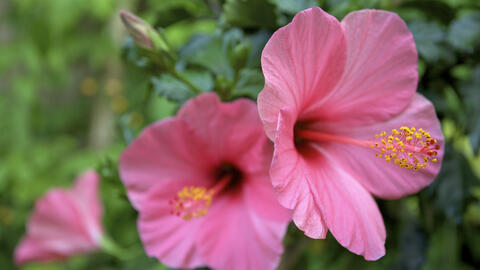How to overwinter Hibiscus
Exotic Hibiscus flowers bring color to the patio in summer. However, Rose Mallow needs an indoor spot in winter. Here are our overwintering tips.

During winter, Rose Mallow does best in a bright spot at around 59 degrees Fahrenheit
How you overwinter your Hibiscus and the right time to bring it indoors depends on which species of Hibiscus you have. While Rose of Sharon (Hibiscus syriacus) is frost-hardy and can spend winter outdoors in a flower bed, the outdoor season is over for Rose Mallow (Hibiscus rosa-sinensis) once temperatures drop below 54 degrees Fahrenheit.
As soon as nighttime temperatures fall below the 54 degree mark, it’s time to move the Hibiscus to its winter quarters. Check your Rose Mallow for pests before bringing it indoors and remove any dead parts of the plant. A good place to overwinter your Hibiscus is by a window in a moderately heated room; a mildly warm conservatory is ideal. The temperature should be around 59 degrees Fahrenheit. It’s also important to find a bright location, otherwise there is a risk that the Hibiscus will shed its leaves. However, due to the differences in temperature and light between summer and winter locations, you cannot usually prevent the Hibiscus from losing some of its buds. Do not put Hibiscus directly in front of a radiator or heater, as hot, dry air can cause pest infestations. Regular ventilation helps prevent spider mite infestations.

Water Hibiscus modestly during the winter rest period so that the root ball is only slightly moist. You do not need to fertilize your Rose Mallow at all while it is inside over winter. You can steadily increase watering in spring and feed the shrub every two weeks with a liquid fertilizer for potted plants. You can put the Hibiscus back outside in a warm and sheltered spot in May.

There are several hundred species of Hibiscus, but only Rose of Sharon, also known as shrub Althea (Hibiscus syriacus), is hardy. However, in cool locations young Rose of Sharon particularly enjoys additional winter protection during its first few years: put bark mulch, dry leaves or fir tree branches around the root area of the shrub.
Evergreen ground cover plants can also help protect against frost. Rose of Sharon is also frost-hardy when grown in pots. Make sure that Hibiscus survives winter by wrapping pots in bubble wrap, using an insulating layer of wood or Styrofoam as a base, and finding a sheltered spot against the wall of the house.



